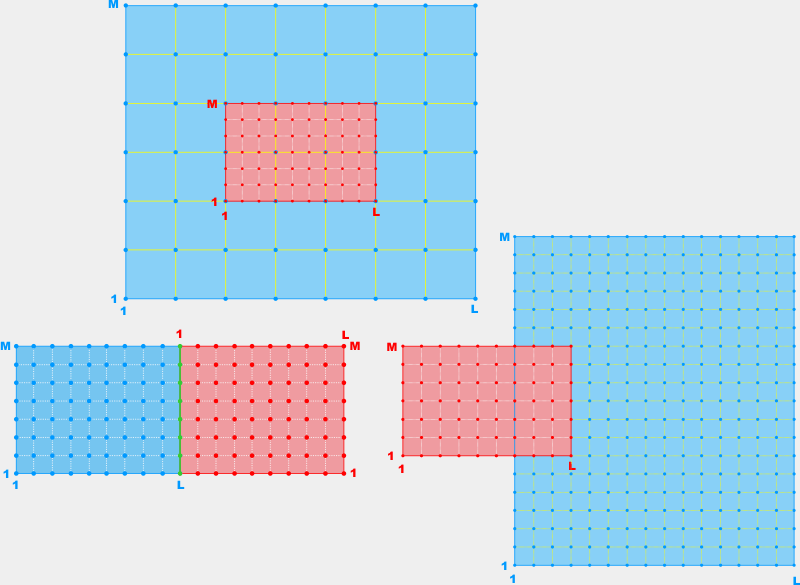The latest version of the
We already have a nesting prototype working but it still needs work. However, nesting is not available yet. We will let know when you can use nesting. There are still more changes to come. Many thanks to John Warner for his help in developing and testing this capability. This version also includes the ESMF drivers for ROMS. Many thanks to the ESMF group (Cecelia Deluca, Gerhard Theurich, and collaborators) for their help. This version works with any ESMF library, version 3.x or higher. More changes are planned for the multi-model coupling. We are now working on the interpolation routines and waiting for ESMF to allow curvilinear grids remaping.
As shown below, three types of multiple grid nesting are possible in ROMS: refined (top diagram), mosaic (lower left diagram), and composite (lower right diagram) grids.

The details of the connectivity between grids are shown and discussed in
What is New:
(*) The lower and upper bound indices per domain partitions for all nested grids are stored in the array structure BOUNDS declared in mod_param.F. These values are now are accessed from the include file set_bounds.h, as follow:
Code: Select all
Istr =BOUNDS(ng)%Istr (tile)
IstrR=BOUNDS(ng)%IstrR(tile)
IstrT=BOUNDS(ng)%IstrT(tile)
IstrU=BOUNDS(ng)%IstrU(tile)
Iend =BOUNDS(ng)%Iend (tile)
IendR=BOUNDS(ng)%IendR(tile)
IendT=BOUNDS(ng)%IendT(tile)
Jstr =BOUNDS(ng)%Jstr (tile)
JstrR=BOUNDS(ng)%JstrR(tile)
JstrT=BOUNDS(ng)%JstrT(tile)
JstrV=BOUNDS(ng)%JstrV(tile)
Jend =BOUNDS(ng)%Jend (tile)
JendR=BOUNDS(ng)%JendR(tile)
JendT=BOUNDS(ng)%JendT(tile)
Code: Select all
DO ng=1,Ngrids
Ntiles=NtileI(ng)*NtileJ(ng)-1
allocate ( BOUNDS(ng) % IstrR(-1:Ntiles) )
...
END DO
The indices IstrT, IendT, JstrT, JendT are used during nesting applications and include the overlap contact points between refined, mosaic, or composite grids. If not nesting, they are set to the same values as IstrR, IendR, JstrR, JendR, respectively.
(*) In the same fashion, the state array lower and upper bounds are available from the BOUNDS structure by including tile.h:
Code: Select all
LBi=BOUNDS(ng)%LBi(tile)
UBi=BOUNDS(ng)%UBi(tile)
LBj=BOUNDS(ng)%LBj(tile)
UBj=BOUNDS(ng)%UBj(tile)
Code: Select all
Old arguments:
CALL omega_tile (ng, Istr, Iend, Jstr, Jend, &
& LBi, UBi, LBj, UBj, &
& ...)
New arguments:
CALL omega_tile (ng, tile, &
& LBi, UBi, LBj, UBj, &
& ...)
Code: Select all
# include "set_bounds.h"
Code: Select all
Old calls:
CALL bc_**d_tile (ng, Istr, Iend, Jstr, Jend, &
& LBi, UBi, LBj, UBj, ...)
CALL exchange_**d_tile (ng, Istr, Iend, Jstr, Jend, &
& LBi, UBi, LBj, UBj, ...)
CALL mp_exchange*d (ng, iNLM, *, Istr, Iend, Jstr, Jend, &
& LBi, UBi, LBj, UBj, ...)
New calls:
CALL bc_**d_tile (ng, tile, &
& LBi, UBi, LBj, UBj, ...)
CALL exchange_**d_tile (ng, tile, &
& LBi, UBi, LBj, UBj, ...)
CALL mp_exchange*d (ng, tile, iNLM, *, &
& LBi, UBi, LBj, UBj, ...)
In general,
SUBROUTINE my_routine (ng, model, Istr, Iend, Jstr, Jend, ...)
was changed to
SUBROUTINE my_routine (ng, tile, model, ...)
(*) The initialize, run, and finalize routines are renamed in all drivers to ROMS_initialize, ROMS_run, and ROMS_finalize, respectively. This allows a differentiation between models when using the ESMF library. The routine ROMS_run has now two arguments Tstr and Tend indicating the number of time-steps to perform. This will be used for squential or concurrent coupling.
(*) An ESMF driver (Master/esmf_coupler.F) was added to couple ROMS to other models. This driver uses the ESMF super-structure to control the flow of information between all models. However, volumetric coupling between ROMS and other models is very hard, if impossible, within the super-structure. We interacted with the ESMF developers group about this weakness in the ESMF library. Although, we understand why the super-structure was designed to allow old legacy codes, time clocks, and parallel synchronization points. Then, Gerhard Theurich developed the direct coupling capabilities within the ESMF library. This is available in ESMF library version 3.1.0p or higher. This implies that is possible to call the ESMF library inside ROMS (say, main3d.F) to allow volumetric coupling and avoid splitting ROMS into different phases because of the super-structure. This also facilitates ESMF usage in the adjoint-based algorithms in the future. This is only possible because the coarse-grained parallelization of ROMS. All the parallel synchronization points are located in main2d/main3d.
(*) The generic ESMF framework registration of the ROMS grided component can be found in Master/esmf_roms.F. This is a quite complex algorithm that took me several weeks to mature and test. It contains the entire ESMF set-up for ROMS with several public and private routines:
Code: Select all
PUBLIC :: ROMS_SetServices
PUBLIC :: ROMS_SetGridArrays
PUBLIC :: ROMS_SetStates
PUBLIC :: ROMS_SetClock
PUBLIC :: ROMS_GetImportData
PUBLIC :: ROMS_PutExportData
PUBLIC :: ROMS_PutGridData
PRIVATE :: ROMS_SetInitialize
PRIVATE :: ROMS_SetRun
PRIVATE :: ROMS_SetFinalize
(*) The coupling.in script was changed substantially to allow generic coupling. The idea here is generalize the coupling from few input parameters instead of changing the complex coupling subroutines. Currently, the fields to export and import are:
Code: Select all
Field Export Import
NONE - - No field to import or export
Pair atmos ocean surface air pressure
Tair atmos ocean surface air temperature
Hair atmos ocean surface air relative humidity
cloud atmos ocean cloud fraction
SWrad atmos ocean shortwave radiation flux
LWrad atmos ocean longwave radiation flux
rain atmos ocean rain fall rate
Uwind atmos ocean, waves surface U-wind component
Vwind atmos ocean, waves surface V-wind component
heat atmos ocean surface net heat flux
Ustr atmos ocean surface U-momentum stress
Vstr atmos ocean surface V-momentum stress
SST ocean atmos sea surface temperature
bath ocean waves bathymetry
SSH ocean waves free-surface
Ubar ocean waves vertically integrated U-momentum
Vbar ocean waves vertically integrated V-momentum
Wdir waves ocean wind-induced wave direction
Wamp waves ocean wind-induced significat wave height
Wlen waves ocean wind-induced mean wavelength
Wptop waves ocean wind-induced surface wave period
Wpbot waves ocean wind-induced bottom wave period
Wdiss waves ocean wave dissipation
Wbrk waves ocean percent wave breaking
My next task is to unify the coupling between ESMF and MCT libraries. We plan to support both. Therefore, more changes are coming in your way.
Good luck with this new version...